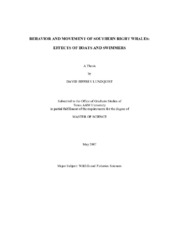| dc.description.abstract | Guidelines for sustainable swim-with tourism for large whales are not welldeveloped,
as researchers have focused on delphinids. Nations that signed the
Convention on Biological Diversity at the Earth Summit in Rio de Janeiro in 1992 are
obligated to consider sustainable use principles when allowing new ecotourism
activities, yet the fast-growing worldwide swim-with-whales industry is lacking the
research needed to create successful management guidelines that can be implemented by
local communities. From September to November of 2005 and July to October of 2006,
I collected movement and behavioral state data for southern right whales in proximity of
swimmers at PenÃÂnsula Valdés, Argentina. Whales were observed before, during, and
after a series of directed interactions with swimmers. I quantified the behavioral and
movement effects relative to group composition of whales (mother/calf pairs, juveniles
or adult/mixed groups) and activity level of swimmers.
Group composition had a significant effect on the response of whales to
swimmers. Swimmer activity level did not substantially affect the reaction of whales.
Resting and socializing activities significantly decreased and traveling activities
significantly increased when boats approached and when swimmers entered the water. Resting and socializing bout length in the presence of swimmers decreased to less than a
third of the length of bouts when swimmers were not present. Whales swam faster,
reoriented more often, and followed a less linear path during interactions. Effects were
greater for mother/calf pairs than juveniles, while mixed adult/juvenile groups showed
no significant changes in behavior or movement. The initial reaction of whales to the
approach of the boat and the entry of swimmers into the water was a good predictor of
the magnitude of effects on the behavior and movement patterns of the whale. Increased
levels of activity are a concern for the whales that are resting and not feeding in this
area. To provide quality resource management guidelines for this activity, additional
research is needed to determine long-term effects of boat and swimmer activities on the
behavior of whales. It is also important to obtain energetic data for right whales to
determine the magnitude of impacts. | en |


